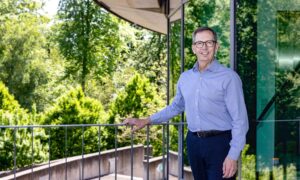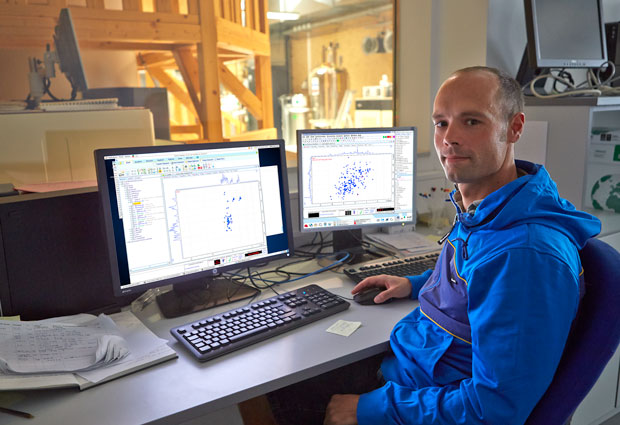
Welcome: Janosch Hennig
Always with an eye on the big picture, new group leader Janosch Hennig will combine nuclear magnetic resonance with a variety of other techniques, and team up with colleagues from different fields to glean meaning from the 3D structure of cells’ molecular machines.

Janosch Hennig is particularly interested in the TRIM family of proteins, which are involved in regulating gene expression and in our immune response. His group will use nuclear magnetic resonance (NMR), combined with small-angle X-ray scattering (SAXS), small-angle neutron scattering and X-ray crystallography, to study the 3D structures of these and other sets of molecules.
A structure alone is not so interesting, you need the biology too.
What inspires you?
Popular science books, also from fields outside my work. Especially in evolutionary biology: I think there are some really good books that show how fascinating the Earth and all its living beings are, and how they have evolved over billions of years. I think this is very inspiring… awe-inspiring, actually! From this you also draw inspiration for doing science, because you want to understand in more detail how everything works and is connected.
Name one tool you can’t do without
Science without a computer is – I just wouldn’t like to try! When I imagine what it must have been like doing NMR 30 years ago, it must have involved extremely long coffee breaks. So as a tool, a computer is just essential. But people managed back then, so it’s not impossible. Few tools are really irreplaceable.
Whose work at EMBL intrigues you? Do you already have potential collaborators in mind?
Of course! I’m trying to recruit an EIPOD candidate with Dmitri Svergun. We hope to work with Anne Ephrussi too, to validate structures in vivo. A structure alone is not so interesting, you need the biology too. If we have a structure then we can make mutations and test their effect in living organisms; if we have a structure that doesn’t make sense biologically, something must be wrong. I also hope to collaborate with Matthias Hentze – his lab had a paper that I found really interesting, identifying new proteins that bind RNA. This is quite a field to harvest: the structures of these so-far unknown RNA binders. Within the Structural and Computational Biology Unit, I hope to collaborate with colleagues using cryo-electron microscopy, to look at really large molecules and the complexes they form; and Christoph Müller and Orsolya Barabas, to get help with X-ray crystallography. NMR is a great tool for metabolomics too, so although I’m not really a metabolomics person, I think it would be interesting for groups like Kiran Patil’s and eventually Peer Bork’s to make use of NMR. And there are so many more opportunities at EMBL.
What is your philosophy for running your lab?
It’s important to let people pursue their own ideas, within a certain framework: people should be motivated, and they are only motivated if you also give them some freedom. I think it’s essential to find time to reflect on how you are perceived by other people. You might not always have time to tread carefully, but I think you have to be aware that some people are simply different from you – and from each other – and you have to keep this in mind if you want to be efficient.
What will you be looking for as you build your group?
Group members should be nice people; people you are able to work with, to communicate with, and who are genuinely interested in science.
If there was a motto hanging at your lab’s door, what would it be?
I don’t have one…I think it depends a lot on the situation and the individual: I try to treat different people in different ways, as I said. You make a lot of things up as you go, but in terms of a motto… OK, people should have fun doing science!
Where do you come from? What are the best things about life science in your country?
I’m from Germany, but I also have a Swedish citizenship, and did my Masters, PhD and a postdoc there. Germany in general is great because there is so much investment in science and research – they’ve been doing excellent science for over 100 years. Sweden has a really nice work philosophy: employees are appreciated much more. A combination of the two would definitely improve how both countries do science.
What’s the best advice you’ve received (or wished you had received) in your career?
I’ve had lots of good advice from mentors, supervisors, and from my parents, but ultimately I think the best lessons actually come from the mistakes you make yourself, and learning from them.
How would you describe your approach to research?
Trial and error! It’s always like this, isn’t it? You have to have an idea in mind and know what you want to achieve in the long run – but how to get there? Things will turn out differently: some things work better than others, others might turn out to be more interesting – you have to be open to that.


